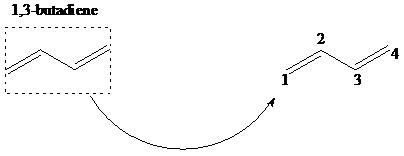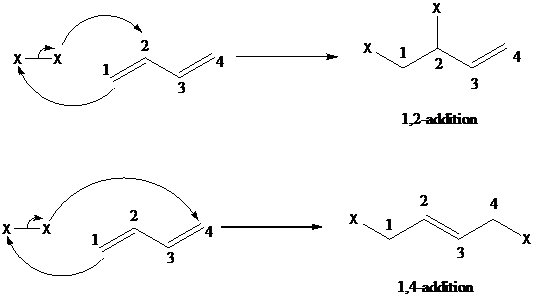
Concept explainers
Interpretation:
Detailed mechanism of hydrobromination via 1,2-addition and 1,4-addition mechanisms using peroxide promoted addition to 1,3-butadiene are to be written.
Concept introduction:
舧 Electrophiles are electron-deficient species, which has positive or partially positive charge. Lewis acids are electrophiles, which accept electron pair.
舧 Nucleophiles are electron rich species, which has negative or partially negative charge. Lewis bases are nucleophiles, which donate electron pair.
舧 Free radical is an atom, molecule, or ion that has an unpaired electron, which makes it highly chemically reactive.
舧 Substitution reaction: A reaction in which one of the hydrogen atoms of a hydrocarbon or a
舧 Elimination reaction: A reaction in which two substituent groups are detached and a double bond is formed is called elimination reaction.
舧 Addition reaction: It is the reaction in which unsaturated bonds are converted to saturated molecules by the addition of molecules.
舧 The reaction in which there is addition of hydrogen molecule is called hydrogenation reaction.
舧
舧 Hydrogenation with platinum as a catalyst is used to convert unsaturated carbohydrates to saturated hydrocarbons
舧 Oxidation of
舧 Ozonolysis helps convert the carbon–carbon double bonds to carbon–oxygen double bond (carbonyl compounds).
舧 Dimethyl sulfide is used as a reducing agent that decomposes the intermediate formed into the carbonyl group.
舧 NBS (nitro-bromo succinimide) is a special reagent used for bromination of allylic carbocations.
舧 Bromine replaces the hydrogen attached to the carbon adjacent to the carbon bearing double bond.
舧 This method of using NBS can produce allylic bromides without bromine reacting with the double bond.
舧 Dehydration of a primary alcohol in the presence of a mineral acid like concentrated sulfuric acid results in the formation of alkene via E2 elimination
舧 The 1,2–addition to a diene is addition of an electrophile to the carbon designated as 1 and a nucleophile to the carbon designated as 2. The positions of carbons as 1 and 2 are not according to the IUPAC numbering of the molecule, but as a conjugated diene molecule. 1,4-addition results in addition of hydrogen to the carbon designated as 1 and a halogen to the carbon designated as 4. The mechanism of 1,2 addition and 1,4-addition of hydro halogenation is given below.


舧 Organic peroxides are used in free radical chain reactions in the initiation steps.
Want to see the full answer?
Check out a sample textbook solution
Chapter 13 Solutions
Organic Chemistry
- Addition of HBr to 3,3-dimethyl-1-butene gives a mixture of two isomeric alkyl bromide products. Please daw structures for the two products, and give a mechanistic explanation for their formation.arrow_forwardDraw and discuss the mechanism (with arrows to show electron movements) of the Diels-Alder reaction between anthracene and maleic anhydride. Draw the orientation and phases of the reacting p-orbitals showing how they overlap in a “suprafacial” geometry to form productarrow_forwardOne step in the synthesis of dodecahedrane involves reaction of the tetraene C with dimethylacetylene dicarboxylate (D) to afford two compounds having molecular formula C16H16O4. This reaction has been called a domino Diels–Alder reaction. Identify the two products formed.arrow_forward
- Write a general rule that can be used to predict the major product of a Diels–Alder reaction between an alkene with an electron-withdrawing substituent and a diene with a substituent that can donate electrons by resonance depending on the location of the substituent on the diene.arrow_forwardAccount for the fact that allylic bromination of 1-octene by NBS gives these products. NBS Br CH,Clg Br 1-Octene 3-Bromo-1-octene (E)-1-Bromo-2-octene (83%) (racemic, 17%)arrow_forwardDiphenylacetylene can be synthesized by the double dehydrohalogenation of 1,2-dibromo-1,2-diphenylethene. The sequence starting from (E)-1,2-diphenylethene consists of bromination to give the dibromide, followed by dehydrohalogenation to give a vinylic bromide, then a second dehydrohalogenation to give diphenylacetylene.(a) What is the structure, including stereochemistry, of the vinylic bromide?(b) If the sequence starts with (Z)-1,2-dibromo-1,2-diphenylethene, what is (are) the structure(s) of the intermediate dibromide(s)? What is the structure of the vinylic bromide?arrow_forward
- When anthracene is added to the reaction of chlorobenzene with concentrated NaOH at 350 °C, an interesting Diels–Alderadduct of formula C20H14 results. The proton NMR spectrum of the product shows a singlet of area 2 around d 3 and abroad singlet of area 12 around d 7. Propose a structure for the product, and explain why one of the aromatic rings ofanthracene reacted as a dienearrow_forwardTreatment of cyclohexene with iodobenzene under the conditions of the Heck reaction might be expected to give 1-phenylcyclohexene. The exclusive product, however, is 3-phenylcyclohexene. Account for the formation of this product.arrow_forwardThe Diels–Alder reaction between butadiene and dimethyl maleate yields a ring structure, as shown in the product. Complete the structure by drawing any missing bonds and indicating the stereochemistry of the new stereocenters.arrow_forward
- 4. 3-chloro-1-butene reacts with sodium ethoxide in ethanol to produce 3- ethyoxy-1-butene. In the absence of sodium ethoxide, 3-chloro-1-butene reacts with ethanol to produce both 3-ethoxy-1-butene and 1-ethoxy-2-butene. Explain these results. Be sure to include mechanisms and structures in your explanation. H. CH2=CH-C-CH3 ÓCH,CH3 GH,-CH=C-CH3 ÓCH,CH, 3-Ethoxy-1-butene 1-Ethoxy-2-butenearrow_forward(a) Draw a Kekulé structure that shows how the reactive positions of anthracene are the ends of a diene, appropriate for a Diels–Alder reaction.(b) The Diels–Alder reaction of anthracene with maleic anhydride is a common organic lab experiment. Predict the product of this Diels–Alder reaction.arrow_forwardreaction of either 3-bromo-1-butene or (Z) -1-bromo-2-butene with water under SN1 condition yields the same product explain whyarrow_forward

 Organic ChemistryChemistryISBN:9781305580350Author:William H. Brown, Brent L. Iverson, Eric Anslyn, Christopher S. FootePublisher:Cengage Learning
Organic ChemistryChemistryISBN:9781305580350Author:William H. Brown, Brent L. Iverson, Eric Anslyn, Christopher S. FootePublisher:Cengage Learning

